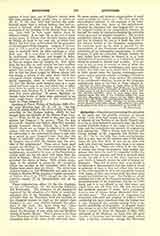

Antipodes. —Speculations concerning the rotundity of the earth and the possible existence of human beings “with their feet turned towards ours” were of interest to the Fathers of the Early Church only in so far as they seemed to encroach upon the fundamental Christian dogma of the unity of the human race, and the consequent universality of original sin and redemption. This is clearly seen from the following passage of St. Augustine (De Civitate Dei, xvi, 9): “As to the fable that there are Antipodes, that is to say, men on the opposite side of the earth, where the sun rises when it sets on us, men who walk with their feet opposite ours, there is no reason for believing it. Those who affirm it do not claim to possess any actual information; they merely conjecture that, since the earth is suspended within the concavity of the heavens, and there is as much room on the one side of it as on the other, therefore the part which is beneath cannot be void of human inhabitants. They fail to notice that, even should it be believed or demonstrated that the world is round or spherical in form, it does not follow that the part of the earth opposite to us is not completely covered with water, or that any conjectured dry land there should be inhabited by men. For Scripture, which confirms the truth of its historical statements by the accomplishment of its prophecies, teaches no falsehood; and it is too absurd to say that some men might have set sail from this side and, traversing the immense expanse of ocean, have propagated there a race of human beings descended from that one first man.” This opinion of St. Augustine was commonly held until the progress of science, whilst confirming his main contention that the human race is one, dissipated the scruples arising from a defective knowledge of geography. A singular exception occurs to us in the middle of the eighth century. From a letter of Pope St. Zachary (May 1, 748), addressed to St. Boniface, we learn that the great Apostle of Germany had invoked the papal censure upon a certain missionary among the Bavarians named Vergilius, generally supposed to be identical with the renowned Ferghil, an Irishman, and late Archbishop of Salzburg. Among other alleged misdeeds and errors was numbered that of holding “that beneath the earth there was another world and other men, another sun and moon”. In reply, the Pope directs St. Boniface to convoke a council and “if it be made clear” that Vergilius adheres to this “perverse teaching, contrary to the Lord and to hi own soul”, to “expel him from the Church, deprive of his priestly dignity”. This is the only information that we possess regarding an incident which is made to figure largely in the imaginary warfare between theology and science. That Vergilius was ever really tried, condemned, or forced to retract, is an assumption without any foundation in history On the contrary, if he was in fact the future Arch bishop of Salzburg, it is more natural to conclude that he succeeded in convincing his censors than by “other men” he did not understand a race of human beings not descended from Adam and redeemed by the Lord; for it is patent that this was the feature of his teaching which appeared to the Pope to be “perverse” and “contrary to the Lord” Instead of narrow censure, the Church and the theologians deserve our highest esteem for having throughout the ages, firmly upheld the important doctrine of the universal brotherhood of the human race. At the same time we recognize that the case of the Irish monk who suffered the penalty of being several centuries in advance of his age remains on the page of history, like the parallel case of Galileo as a solemn admonition against a hasty resort to ecclesiastical censures. (See also Vergilius; Zachary.)
JAMES F. LOUGHLIN

